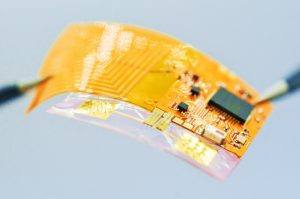A wearable patch that uses electrically triggered microneedles for on-demand, subcutaneous drug delivery shows promise for the treatment of neurodegenerative disorders and neurological injuries, according to a UNC-Chapel Hill paper in the journal Nature Communications.

The research is funded by a $25,000 pilot grant awarded by the UNC School of Medicine and UNC Health to Wubin Bai, assistant professor in the department of applied physical sciences, and Juan Song, professor in the department of pharmacology. They were one of seven research teams awarded grants whose goal is to increase collaboration throughout the neurosciences at UNC.
This novel drug delivery system, called the Spatiotemporal On-Demand Patch (SOP), can receive commands wirelessly from a smartphone or computer to schedule and trigger the release of drugs from individual microneedles. The patch’s thin, soft platform resembles a Band-Aid and was designed to enhance user comfort and convenience, since wearability is a crucial factor for chronically ill patients.
“SOP’s ability to enable joint delivery of multiple drugs can address various aspects of Alzheimer’s Disease, such as reducing beta-amyloid plaques, mitigating neuroinflammation and enhancing cognitive function,” said Bai, a co-author of the article “Digital Automation of Transdermal Drug Delivery with High Spatiotemporal Resolution” with Yihang Wang of the department of applied physical sciences and Zeka Chen of the department of pharmacology.
In addition, Bai said the research highlights not only a multidisciplinary collaboration but also a “passionate involvement of Carolina undergraduate students,” including Priyash Hafiz of the department of applied physical sciences and Brayden Davis, Will Lipman, Tian Wang and Sicheng Xing of the UNC/NCSU joint department of biomedical engineering.

The patch, which has received a provisional patent, enables highly localized treatment—less than 1 square millimeter—of specific tissues, organs or regions within the body, and drug release can be triggered within 30 seconds in response to an electrical signal. Patients can wear more than one patch at a time, which will reduce the need for doctors’ visits, or even trips to the hospital, for medical attention.
“The beauty of this device is that it can house dozens, if not hundreds, of concentrated drugs and can program their sequential release automatically,” said Song. “Rapid drug release can be crucial in emergency situations or when immediate therapeutic action is required.”
The microneedles are coated with gold, which protects the drugs and surrounding tissues. When a low-voltage electrical stimulus is applied through the patch, the gold coating disintegrates, exposing the drug-loaded microneedles to the skin and initiating the controlled release of the drugs.
“This level of specificity ensures precise and customized drug delivery, catering to the needs of different conditions or specific regions of the body,” said Wang. “This offers a novel approach to achieving controlled drug release through a combination of materials science and electrical engineering.”
By David DeFusco, Department of Applied Physical Sciences
